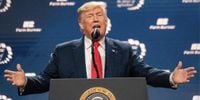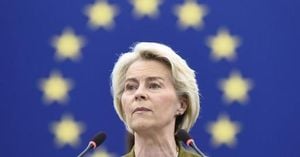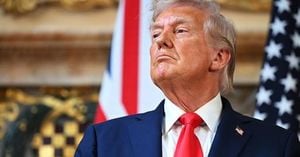For months, the phrase "Elbows Up" was shorthand for a combative Canadian stance toward U.S. trade policy, especially in the face of tariffs imposed by President Donald Trump. But as summer 2025 draws to a close, Prime Minister Mark Carney has quietly shelved that approach, signaling a significant shift in Ottawa’s strategy—and in public opinion—toward America’s unpredictable trade tactics.
Carney, who rode into office in April 2025 partly on promises of standing up to Trump with dollar-for-dollar tariffs, has since charted a more pragmatic course. According to Postmedia, he abandoned the aggressive "Elbows Up" rhetoric almost immediately after his victory, recognizing the harsh economic reality: Canada’s economy is a tenth the size of the United States’. A tit-for-tat tariff war, Carney concluded, would be a losing battle for Canadians.
This pivot is more than just a matter of political calculation. According to a Leger/Postmedia poll released the week before August 17, 2025, public support for the "Elbows Up" approach has eroded dramatically. Just six months ago, 73% of Canadians backed the idea of full retaliatory tariffs on U.S. goods. Now, that number has plummeted to 45%, nearly neck-and-neck with the 41% who prefer a more measured approach—one that seeks a deal with Trump, even if it means some tariffs on Canadian goods remain in place.
The polling numbers tell a story of a country rethinking its appetite for confrontation. As Postmedia reports, Canadians are increasingly skeptical of the Carney government’s "Elbows Up" strategy. The once-popular idea of going toe-to-toe with Washington on tariffs is losing its appeal, replaced by a desire for practical solutions, even if they come with compromise.
Carney’s actions since taking office reflect this changing mood. One of his first moves was to remove the counter-tariffs his government had imposed on a range of imported American goods—tariffs that, in practice, raised prices for Canadian consumers and businesses. According to Postmedia, these tariffs had been designed to hit back at Trump’s measures, but Carney quickly recognized their domestic cost and reversed course.
Another early flashpoint was the Liberals’ digital services tax, a policy Trump vocally opposed. Within days of Trump’s demand, Carney’s government scrapped the tax entirely. This decision, while controversial among some Liberal loyalists, was seen as a clear olive branch to Washington and a signal that Canada was willing to prioritize broader trade stability over sticking to every campaign promise.
As Carney has shifted gears, he’s also worked to lower expectations about what a new agreement with the U.S. might look like. Gone is the bold talk of eliminating all Trump-era tariffs. Instead, Carney has openly acknowledged that any deal may include some U.S. tariffs on Canadian goods. According to Postmedia, he has also made it clear that Canada’s position is that no deal is better than a bad deal—a line that resonates with many Canadians wary of being strong-armed by their southern neighbor.
But what does this mean for the future of North American trade? Some of the tariffs Trump has already imposed could become permanent fixtures, at least for now. This reality looms large as the renegotiation of the Canada-U.S.-Mexico Agreement (CUSMA) approaches in 2026. Trump, who originally agreed to CUSMA during his first term, once hailed it as "the fairest, most balanced, and beneficial trade agreement we have ever signed into law … the best agreement we’ve ever made." Yet, with the current climate of uncertainty and shifting leadership styles, the path to renewing or revising CUSMA is anything but clear.
For Carney, the balancing act is delicate. On one side are Canadians who want to see their leaders stand up to American pressure. On the other are those who fear the economic fallout of a prolonged trade war. The latest Leger/Postmedia poll underscores this divide: support for the hardline "Elbows Up" approach has softened, but nearly half the country still wants to see some form of robust response to Trump’s tariffs.
“Canadians are increasingly skeptical of the Carney government’s ‘elbows up’ approach to U.S. trade disputes, with new polling suggesting the dollar-for-dollar tariff response is losing its appeal,” Postmedia noted, capturing the mood of a nation caught between pride and pragmatism.
It’s not just public opinion that’s shifting. Business leaders and economists have long warned that counter-tariffs often end up hurting Canadian companies and consumers more than their intended U.S. targets. Imported American goods are essential for many Canadian industries, and higher tariffs can mean higher prices, supply chain disruptions, and lost jobs north of the border. Carney’s decision to remove many of these counter-tariffs reflects a growing consensus that self-inflicted wounds are not a winning strategy.
Yet, Carney’s willingness to compromise has drawn criticism from some quarters. Detractors argue that backing down sends the wrong message to Washington and risks emboldening Trump to push for even more aggressive trade measures. They point to the rapid abandonment of the digital services tax as evidence that Canada is too quick to fold under pressure. Supporters, meanwhile, contend that Carney is simply facing economic reality and acting in the best interests of Canadians who ultimately bear the cost of a trade war.
Looking ahead, the stakes are high. The 2026 CUSMA renegotiation will test Carney’s diplomatic skills and Canada’s economic resilience. Trump’s praise for the original deal—calling it "the fairest, most balanced, and beneficial trade agreement we have ever signed into law"—offers little assurance that future talks will be smooth. If anything, it sets a high bar that both sides may struggle to meet given current tensions.
For now, Carney’s message is clear: Canada will not accept a bad deal, but it also won’t pursue confrontation for its own sake. The days of "Elbows Up" bravado are over, replaced by a cautious pragmatism that seeks to protect Canadian interests without stoking unnecessary conflict. Whether this approach will deliver results at the negotiating table—or satisfy a divided public—remains to be seen.
As the dust settles on this latest chapter in Canada-U.S. trade relations, one thing is certain: the era of simple slogans and easy answers has passed. The choices ahead will require nuance, patience, and, above all, a willingness to adapt to a world where economic realities trump political posturing.




